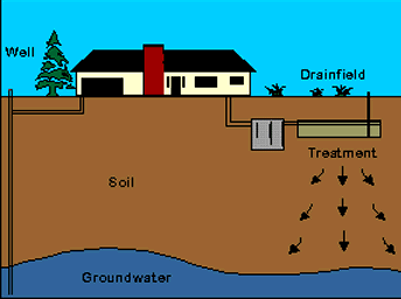Difference between revisions of "Practitioner's Tool / Settled Sewers"
m (Winona moved page Settled Sewers to Practitioner's Tool / Settled Sewers without leaving a redirect) |
(→Links) |
||
| Line 17: | Line 17: | ||
| − | ''[[Practitioner's Tool | + | ''[[Practitioner's Tool / Sewers Comparison|Back to Sewers Comparison]]'' |
| − | |||
| − | |||
Latest revision as of 22:54, 22 November 2016
The settled sewerage system is widely used in Australia, the United States, Nigeria, Brazil, South Africa and other countries. It started out as an upgrade to septic tanks after common septic tank failure problems occurred. Its design prevents solids present in household wastewater from entering the sewer network. Wastewater is allowed to settle in a household septic tank to remove suspended solids before its effluent is conveyed to a treatment site. Due to the absence of solids, small pipes and lower gradients can be used for transportation of the effluent. In the absence of a septic tank, an interceptor box can be used.
The settled sewerage system costs 30-50% less than the conventional sewage system. Lack of solids flowing through the pipes allows for smaller pipes and lower gradients instead of bigger, more expensive pipes. Since most septic tanks are located in the backyard of most homes and buildings in developing countries, the cost of constructing pipes under roads is reduced. Self-cleansing velocity is also not necessary since there are no solids flowing through.
The flow of effluent through the pipes mainly relies on gravity. In areas where the elevation of the land does not support the flow by gravity, pumps can be used. Since there are no solids flowing through, a simple water pump can be used instead of the more expensive sewer pumps.
Operation and maintenance of the settled sewerage system involves desludging the tank annually or biennially to avoid build up of solid waste in the tank and overflow of solids into the effluent pipe.
Links
- Settler: A settler is a primary treatment technology for wastewater; it is designed to remove suspended solids by sedimentation. It may also be referred to as a sedimentation or settling basin/tank, or clarifier. The low flow velocity in a settler allows settleable particles to sink to the bottom, while constituents lighter than water float to the surface.
- Settled sewerage (small diameter): Settled sewerage, also called small diameter or small-bore sewerage is designed to prevent solids in wastewater from entering a communal small bore sewer network.
- More settled sewer information on SuSanA.org

